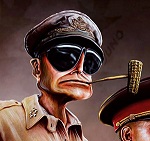|
Xander77 posted:So basically... ? Lend out the book that I gave ya. Sources in there. Too lazy to look it up. Clausewitz or something.
|
|
|
|

|
| # ? May 26, 2024 10:49 |
|
bewbies posted:Modern FLIR sights are really, really good in practically all conditions including in high ambient temperatures. They can detect extremely small differences in temperature and since practically all things have different thermodynamic properties it is practically impossible to defeat unless you have some sort of conclusive temperature-absorbing thing between you and the sensor. I work with the civilian grade FLIR cameras. They aren't commonly used for surveillance but they pop up from time to time for perimeter detection. Generally you'll deploy one to cover a two mile fence line. With a 320 x 240 resolution sensor they can pretty accurately spot and identify a human being using the analytics package. Unlike a lot of CCTV analytics packages the accuracy is quite high. That's the civilian grade stuff in the $4000 a pop range. I assume most of the military grade stuff is probably 640 x 480 and can do an amazing job of spotting people with the same field of view. The fun part about thermals is that they can do a pretty good job of spotting people and if they are close enough I can tell the difference between a person who has a fever and doesn't. And a weird quirk of thermal cameras. If something does a great job of blocking IR you can't see through it. One of the things that does an amazing job of blocking IR light is standard glass. You can't see through it and it will reflect IR light you send at it unless it's specially treated.
|
|
|
|
Thomamelas posted:I work with the civilian grade FLIR cameras. They aren't commonly used for surveillance but they pop up from time to time for perimeter detection. Generally you'll deploy one to cover a two mile fence line. With a 320 x 240 resolution sensor they can pretty accurately spot and identify a human being using the analytics package. Unlike a lot of CCTV analytics packages the accuracy is quite high. That's the civilian grade stuff in the $4000 a pop range. I assume most of the military grade stuff is probably 640 x 480 and can do an amazing job of spotting people with the same field of view. Uh a 320 pixel array covering a line 2 miles long means that a pixel is 10 metres wide. Supposing your imager covers 30 degrees of arc, at the 2000 metre effective range of an ATGM, a back of the envelope calculation says your 640 wide array has each pixel be about 2 metres. I am highly skeptical you can identify a human being based on this data, given your soldier, standing up without any cover, is literally smaller than a single pixel. Also in the ambush scenario, the attacker isn't moving. You are. The landscape is scrolling across your field of view at many mph and you are juddering up and down. Good luck spotting a head poking out of a foxhole in that.
|
|
|
|
bewbies posted:Quite the opposite, I've used thermal sensors in combat and in a really wide variety of operational conditions. If the guy in your anecdote couldn't tell the difference between people and rocks, he must have been using a much older generation of thermal sensor. His image probably looked like the one here on the right, or worse: Did somebody shoot that dog? Who would do such a thing.
|
|
|
|
You might want to check out the chinese food thread.
|
|
|
|
One thing I remember my grandad telling me about the Winter War (he didn't speak much about the war, after his death we went through his papers and realized he had been in really lovely spots) is a captain or a major who gave a pep talk before a Soviet attack. "When the Russian tanks break through, just let them through, no one's gonna sell them gas anyway"
|
|
|
|
Fangz posted:Uh a 320 pixel array covering a line 2 miles long means that a pixel is 10 metres wide. Supposing your imager covers 30 degrees of arc, at the 2000 metre effective range of an ATGM, a back of the envelope calculation says your 640 wide array has each pixel be about 2 metres. I am highly skeptical you can identify a human being based on this data, given your soldier, standing up without any cover, is literally smaller than a single pixel. Pixels would light up upon detection of IR, the IR of the given area at range would rise upon detection of something warm in it, it would become brighter. It wouldn't look like a person but you'd definitely know something was there. But in his case it was to cover a fence line which means at best he'd be the ambusher rather than the ambushee, so you aren't wrong by any means.
|
|
|
|
For a fixed camera, even with the very low PPF allows the analytics to work with that FoV out to about 1.25 to 1.30 miles depending on the lens. One of the things to understand is that the human being is a light source. The body heat we give off is what the camera is seeing. It makes it pretty easy for the analytics to filter out things that aren't people. I've never looked through one of the sensors they use on military vehicles but the civilian grade ones are quite capable using colors to make things stand out. So you get the normal greyscale image but anything that is near human body temperature you can color to make it easy to spot. I have no idea if they are using that capability but it's something that can be done. You're right that it won't be perfect for determining if the people at 2000 meters are just civilians, or a team preparing an AGTM. But it will tell me there are people out there. You can't quite treat them as regular cameras when you think about their resolution because it doesn't map out quite right. And they don't really work like IR illuminators for security cameras, although you can do something fairly close. It's really just a very accurate heat map rendered in such a way that we can see it visually. But it can provide a very granular level of detail even with the low resolution. They aren't impossible to defeat however. At 2000m if you dig a trench and stay in it, you probably can avoid being seen. And I certainly can't tell friend from foe. But it certainly provides a pretty dramatic improvement for situational awareness. You can tell a rock from a person, from a tree pretty easily. It even makes spotting a vehicle that's had it's engine running recently pretty easy. It's not magic but it is pretty drat cool.
|
|
|
|
So, I can understand the visual aspects of this. But how is this artificially coloured image actually displayed to the crew? How big is the monitor(s) (or maybe it's a periscope type deal?) and where is the camera pointed at any given time? How do you operate the camera and how wide a field of view have you got? It seems pretty straightforward that if a bunch of dudes are hiding behind rocks/in a ditch/behind a crest off to the side somewhere with an ATGM, and you're simply not looking in the right direction at the time, with all your hatches shut, at least one vehicle will have it's poo poo wrecked instantly. In a more practical sense it seems that even if you see the enemy, if they're well dug in then unsupported tanks aren't going to be able to avoid at least a couple of losses because of the difficulty inherent in engaging entrenched infantry in a hurry. I don't think you can realistically rely on surprising infantry with a column of armour. Really it just seems like tanks are a lot more vulnerable nowadays than they used to be and infantry is proportionally much more lethal. That's not taking into account air power, which gives me the feeling that a modern infantryman (in a conventional war) would rarely end up even seeing a tank before it's blown up, unless he's on the really-badly-losing side. Slavvy fucked around with this message at 00:24 on Feb 13, 2015 |
|
|
|
|
Slavvy posted:So, I can understand the visual aspects of this. But how is this artificially coloured image actually displayed to the crew? How big is the monitor(s) (or maybe it's a periscope type deal?) and where is the camera pointed at any given time? How do you operate the camera and how wide a field of view have you got? It seems pretty straightforward that if a bunch of dudes are hiding behind rocks/in a ditch/behind a crest off to the side somewhere with an ATGM, and you're simply not looking in the right direction at the time, with all your hatches shut, at least one vehicle will have it's poo poo wrecked instantly. This is pretty much the norm in Syria. Regime has lost a lot of tanks to precisely this.
|
|
|
|
What I'm interested to know is the difference between commercial and military sensors. Bewbies described his experience - the only combat relevant one itt - as being able to read the lettering on individual soldiers' uniforms. Thomamelas said that on commercial surveillance you can basically tell that something is happening in a general area. Though presumably both the scope and capabilities of these systems are radically different?
|
|
|
|
Cryptonomicon posted:The Americans have invented a totally new bombing tactic in a middle of a war and implemented it flawlessly. His mind staggers like a drunk in the aisle of a careening train. They saw that they were wrong, they admitted their mistake, they came up with a new idea. The new idea was accepted and embraced all the way up the chain of command. Now they are using it to kill their enemies. Edit - oh, right. Military history thread. So I need to clarify. I'm really couldn't give a poo poo about bomb skipping, whatever that is. I'm interested in the notion that the Japanese army / fleet frowned on innovation, for more or less dogmatic / cultural reasons. I'd like some well known examples of their improvisations and initiative if false, and an explanation if true. Xander77 fucked around with this message at 01:04 on Feb 13, 2015 |
|
|
|
Xander77 posted:Can someone give me a quick sketch of how and why this is complete and utter bullshit? because it comes from a fiction book written by a sword-o-phile. e: That isn't to say skip-bombing wasn't a thing that happened, nor was it only a ETO dambuster tactic. Bombers did do it, but keep mind mind that you were basically taking high-altitude bombers down to torpedo-bomber-ish height, leveling out, and all the while hoping these gigantic targets don't get blown apart by the AA batteries on the ships they're trying to bomb. FAUXTON fucked around with this message at 00:48 on Feb 13, 2015 |
|
|
|
I don't think being able to read individual lettering solves the tactical problem here. Yes you can zoom right in and do that, but if you do so you narrow your FOV and miss what is going on off screen - so that stuff is only useful if you know where to look.
|
|
|
|
Neal Stephenson is wrong on default on anything that pertains 1) to the Glorious Nippon 2) to swords. This sort of view is born from the complete ignorance of the Sino-Japanese war which was the defining reference point for developing non-naval bomber capabilities of the Empire. The Japanese bomber arm carried out thousands of attacks against Chinese cities, most of them unopposed in any meaningful sense. They didn't care about honour, they cared about doctrine, which did cost them dearly indeed, but not for the romantic reasons people like Stephenson love to masturbate over.
|
|
|
|
steinrokkan posted:What I'm interested to know is the difference between commercial and military sensors. Bewbies described his experience - the only combat relevant one itt - as being able to read the lettering on individual soldiers' uniforms. Thomamelas said that on commercial surveillance you can basically tell that something is happening in a general area. Though presumably both the scope and capabilities of these systems are radically different? I'm guessing there isn't a whole lot of difference between civilian and military system capabilities outside of being able to target with military sensors. That being said, I think there is some...confusion on what exactly a FLIR sensor gives you. It is an enhancement of visual sensors; it doesn't give you x-ray vision and it can't detect motion any better than your eyes can, though it can draw your attention to motion which can be helpful. So, when you're using a FLIR scope, you have to use it in much the same way you would something like optics. That is, constantly scanning, looking for danger spots, etc. It is just like binoculars or something in that respect. The two big things that it does give you are exceptional detection in low light (as compared to optical sensors or your eyes), and the ability to target instantaneously and very accurately based off its image. It adds a ton to your general situational awareness particularly at night or in low visibility and that is probably the most important thing when dealing with stuff like ambushes. Slavvy posted:Really it just seems like tanks are a lot more vulnerable nowadays than they used to be and infantry is proportionally much more lethal. You're very correct, and it isn't just infantry, it is just about everything. A wide variety of sensors are can detect something like a tank very effectively, munitions target and deliver a ton of firepower very precisely. All of this is what is pushing the tank towards obsolescence; the only real way to survive the future battlefield is to defeat ISR, and a massive hunk of steel and uranium being pushed about by a massive red-hot engine is about as easy to detect as anything. bewbies fucked around with this message at 01:14 on Feb 13, 2015 |
|
|
|
FAUXTON posted:because it comes from a fiction book written by a sword-o-phile. I believe it was used quite a bit by B-25s (PBJs if flown by Marines) in the PTO for attacking transports. Bombing ships from high altitude is laughably ineffectual, but skip bombing allowed for the bomber crews to hit and sink merchantmen quite reliably. The B-25 also had a LOT of forward firepower. Fixed MGs in the nose and cheeks, sometimes a 75mm cannon, and a couple of gunner positions allowed for it to do a pretty good job of suppressing light AA on those ships. It likely would have been murder on the aircrews if they attacked a proper convoy but the Japanese didn't run those.
|
|
|
|
Xander77 posted:I'm really couldn't give a poo poo about bomb skipping, whatever that is. I'm interested in the notion that the Japanese army / fleet frowned on innovation, for more or less dogmatic / cultural reasons. I'd like some well known examples of their improvisations and initiative if false, and an explanation if true. Does kamikaze ring a bell? The Ohka stupid bomb? Strategic submarines carrying bombers? Sneaky miniature submarines? Low altitude attacks carried out by Japanese bombers (see picture below)? Very significant innovative use of siege artillery during the battle of Port Arthur? Changes in defensive doctrine made throughout the war? (Basically the Japanese realized they needed guidelines for defensive operations even though their former dogmatic views saw the defensive as inadmissible for Japanese officers)  It's quite clear the Japanese were happy to exploit every opportunity afforded to them by their procured weapons, regardless of how "warrior-like" they might seem.
|
|
|
|
Xander77 posted:Can someone give me a quick sketch of how and why this is complete and utter bullshit? Well would you want to go on a low altitude attack against American AA if you didn't intend to die? American planes were considerably more rugged and they had good selections of rockets and heavy guns to suppress AA. They were going up against enemies that didn't have particularly good automatic AA. Plus Japan was trying to conserve strength to fight combat forces, so striking transports wasn't a priority for them like it was for the US until it was time for the yet more effective kamikaze. Plus a lot of the likeliest candidates for skip bombing could carry torpedoes, and against warships you want a torpedo.
|
|
|
|
Xander77 posted:Can someone give me a quick sketch of how and why this is complete and utter bullshit? Take that example... It took nearly a year for the US to admit that their torpedoes didn't work, and then a bit longer to fix them. That sounds like the inflexible but proud Japanese? Whereas when the Japanese went on the defensive, they quickly changed their tactics to create incredibly tenacious island fortresses that required an appalling amount of casualties to root out. Sure, they didn't quite realize that the US was "in it to win it" until it was too late to gracefully tap out, but the notion that they were honorbound automotons is orientalism at its finest.
|
|
|
bewbies posted:I'm guessing there isn't a whole lot of difference between civilian and military system capabilities outside of being able to target with military sensors. I would've thought that further developments in point defence against missiles and the like would even things out again, but with no cold war to gear up for I guess there isn't much incentive.
|
|
|
|
|
The Battle of the Bismark Sea is a good example of the use of Skip Bombing and related tactics.
|
|
|
|
Were Gatling guns or any other rapid fire gun ever used in a line battle? I know they were used against the Zulus, but that is about it.
|
|
|
|
SquadronROE posted:Were Gatling guns or any other rapid fire gun ever used in a line battle? I know they were used against the Zulus, but that is about it. The French used them to occcasional good effect in the Franco-Prussian War. http://en.wikipedia.org/wiki/Mitrailleuse
|
|
|
SquadronROE posted:Were Gatling guns or any other rapid fire gun ever used in a line battle? I know they were used against the Zulus, but that is about it. The Civil War only saw a tiny bit of product testing of the Gatling Gun; it saw heavy use starting with the Indian Wars later on. It did feature some other neat guns, though, like the Agar Gun. It was a single-barreled crank gun that used a sort of primitive metallic cartridge system: you loaded steel tubes with a primer, powder, and bullet (or just a primer and nitrated paper cartridge) and put them into a hopper, with the crank feeding the gun. It even had a gun shield to protect the gunners. It suffered from some overheating problems and you needed to reload the casings by hand, but it was a very cool tool. Unfortunately the Ordnance Department didn't take a shine to them and they mostly saw their use guarding bridges. Organ guns (a bunch of barrels in a row that would be touched off by a primer and powder train) were in the same boat.
|
|
|
|
|
That reminds me, is it valid to think that without the Ordnance Department holding things back, there would have been large numbers of repeating rifles in use, possibly shortening the war?
|
|
|
|
Fangz posted:I don't think being able to read individual lettering solves the tactical problem here. Yes you can zoom right in and do that, but if you do so you narrow your FOV and miss what is going on off screen - so that stuff is only useful if you know where to look. It increases the chance of detection. It's not a magic button that makes the threat of ambush go away. But it makes it harder to accomplish the ambush by increasing the ability of a crew to detect the ambush. Is it going to let them detect 100% of the time? No. Can it add a significant chance? Yes. And if the enemy has to ambush at longer range then you might gain some better chance of a shot missing, hitting a less vulnerable area or hitting something that disables the tank but spares the tank crew. It can also help reduce some confusion at night in a night battle. And I suspect the sensors for tanks and various land vehicles are fixed rather then the PTZ versions. Mostly because the PTZ versions that FLIR produces that are gyro stablized are $Texas even for the military.
|
|
|
|
sullat posted:honorbound automotons Well, they're honorbound not to lose and killing enemies is the warrior way
|
|
|
|
AceRimmer posted:That reminds me, is it valid to think that without the Ordnance Department holding things back, there would have been large numbers of repeating rifles in use, possibly shortening the war? I doubt it. Production was a challenge, and supply chain and logistics concerns were significant as well.
|
|
|
|
KYOON GRIFFEY JR posted:I doubt it. Production was a challenge, and supply chain and logistics concerns were significant as well. Production too, you've gonna have to set up some cartridge factories whereas minie balls are easy and are already being mass produced.
|
|
|
steinrokkan posted:What I'm interested to know is the difference between commercial and military sensors. Bewbies described his experience - the only combat relevant one itt - as being able to read the lettering on individual soldiers' uniforms. Thomamelas said that on commercial surveillance you can basically tell that something is happening in a general area. Though presumably both the scope and capabilities of these systems are radically different? You can read the nametapes on someones uniform at like 100m. But to see the nametapes, you have to be looking at the right spot. Fangz posted:I don't think being able to read individual lettering solves the tactical problem here. Yes you can zoom right in and do that, but if you do so you narrow your FOV and miss what is going on off screen - so that stuff is only useful if you know where to look. This is it. The time it takes to acquire a target increases dramatically when the commander's vision is reduced(low/no light, buttoned up). Which is what led to this whole string of posts: I didn't understand his point. You could have the best sights in the world, but they only cover a very limited field. To get decent resolution, they cover an even tinier window. Once the commander is supressed, you lose a tremendous amount of situational awareness. Gunning on a turreted vehicle is like being a half blind, totally deaf, parapalegic. You barely have any idea whats going outside of your sights. Half the time you can't even tell which way you're looking without using reference points inside the vehicle(when I'm looking at that panel, I'm facing 3 oclock. When my toes hit that electrical conduit...etc) Yes, you have periscopes and a radio but they are a very poor aproximation of standing up and using your own senses to see.
|
|
|
|
|
Taerkar posted:The Battle of the Bismark Sea is a good example of the use of Skip Bombing and related tactics. Yeah, that's the event that Stephenson is describing when Goto Dengo realizes that Glorious Nippon's rigid warrior code is no match for the devilish Yankee ingenuity. Which may be a rational thought process to someone that barely survives a bombing, and then the New Guinea jungles, but not the kind of analysis we would hope for from a professional historian, and not a conclusion we should take seriously.
|
|
|
|
Raskolnikov38 posted:Production too, you've gonna have to set up some cartridge factories whereas minie balls are easy and are already being mass produced. Mass produced? I thought they just gave individual soldiers lead and they made 'em in molds at the campfire, just like earlier musket balls?
|
|
|
|
Grand Prize Winner posted:Mass produced? I thought they just gave individual soldiers lead and they made 'em in molds at the campfire, just like earlier musket balls?
|
|
|
|
Interesting. My grandpa used to have something like this (but only with a single chamber, not two) and he said he thought it was from the civil war. Were they niche items for weirdo survivalists at that point or something?
|
|
|
|
Grand Prize Winner posted:Interesting. My grandpa used to have something like this (but only with a single chamber, not two) and he said he thought it was from the civil war. Were they niche items for weirdo survivalists at that point or something?
|
|
|
|
Grand Prize Winner posted:Interesting. My grandpa used to have something like this (but only with a single chamber, not two) and he said he thought it was from the civil war. Were they niche items for weirdo survivalists at that point or something? A lot of ammo by that point was mass-produced. For example, most round lead shot/balls in the late 18th century were being made by dropping lead off of tall buildings... http://en.wikipedia.org/wiki/Shot_tower
|
|
|
|
That's nice. I've never heard about that before.
|
|
|
|
Grand Prize Winner posted:Mass produced? I thought they just gave individual soldiers lead and they made 'em in molds at the campfire, just like earlier musket balls? Paper cartridges were standardized issue for everyone from the early 1700s and had been around since the mid 1500s. Casting bullets by hand is an inefficient waste of time. Why ship 12 lbs of lead to get 10 lbs of shot of dubious quality when you can just ship 10 lbs of mass produced shot? Plus, then you are either relying on your soldiers to measure powder for each shot (lmao) or make paper cartridges (also lmao, since cartridge manufacture is a fairly involved and specialized process)
|
|
|
|

|
| # ? May 26, 2024 10:49 |
|
Ensign Expendable posted:You can buy some pretty substantial modernization packages for T-55s, actually. It's far from a dead platform. The same is true for the Leopard 2, strangely enough. The Bundeswehr got 20 new 2A7 in 2014. Probably more this year, if the crisis in the east doesn't stop.
|
|
|





































